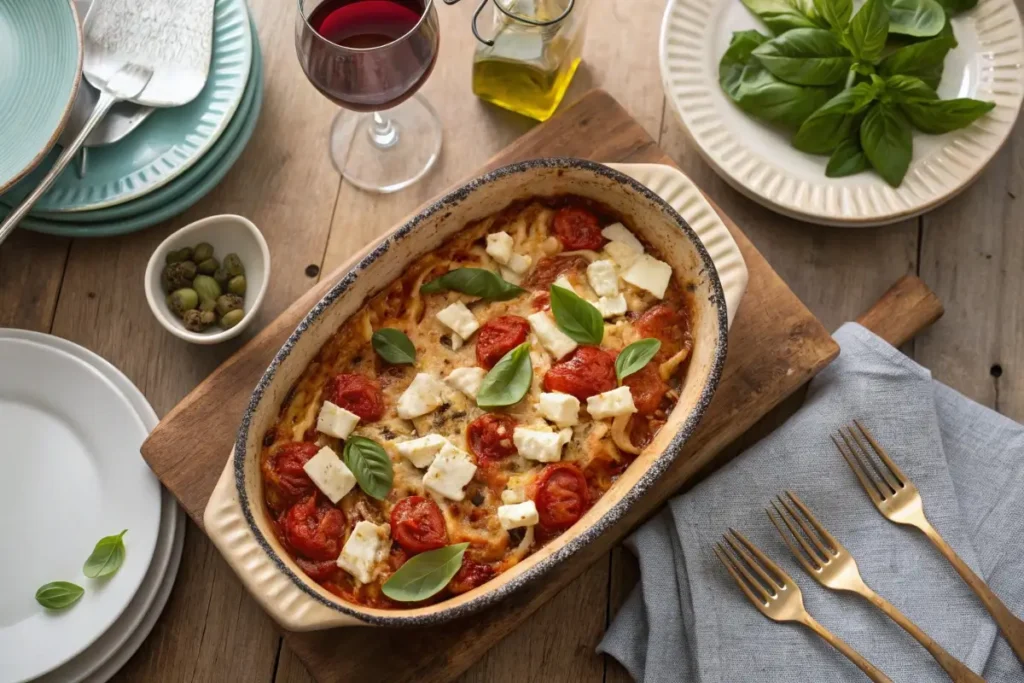Baked feta pasta is more than just a recipe—it’s a global sensation that has won the hearts of home cooks everywhere. Its simplicity, vibrant flavors, and versatility make it a perfect choice for any meal, whether you’re feeding a family or hosting guests. In this comprehensive guide, we’ll explore every detail about baked feta pasta—from its origins and ingredients to tips for perfecting the dish and creative variations. By the end, you’ll be ready to impress with your own version of this viral classic.
Introduction to Baked Feta Pasta (Expanded)
The Viral Sensation: How Baked Feta Pasta Took Over Social Media
It all began in Finland, where food blogger Jenni Häyrinen shared her now-famous “Uunifetapasta” recipe in 2019. The dish quickly gained traction locally, but its global breakthrough came in 2020 when TikTok and Instagram users discovered its simplicity and appeal. Videos of baked feta pasta flooded feeds, with millions recreating the dish and adding their own twists. The recipe became one of the most searched dishes online, proving how social media can turn even the simplest ideas into worldwide phenomena.
Why Everyone Loves Baked Feta Pasta
Baked feta pasta is loved for its minimalism. With just a few ingredients, it delivers big on flavor, making it a go-to for busy cooks and food enthusiasts alike. Its Mediterranean roots—highlighting fresh produce, high-quality olive oil, and creamy feta—give it universal appeal. Plus, its versatility allows endless customizations, ensuring there’s a version to suit every taste.
Ingredients and Their Roles (Expanded)
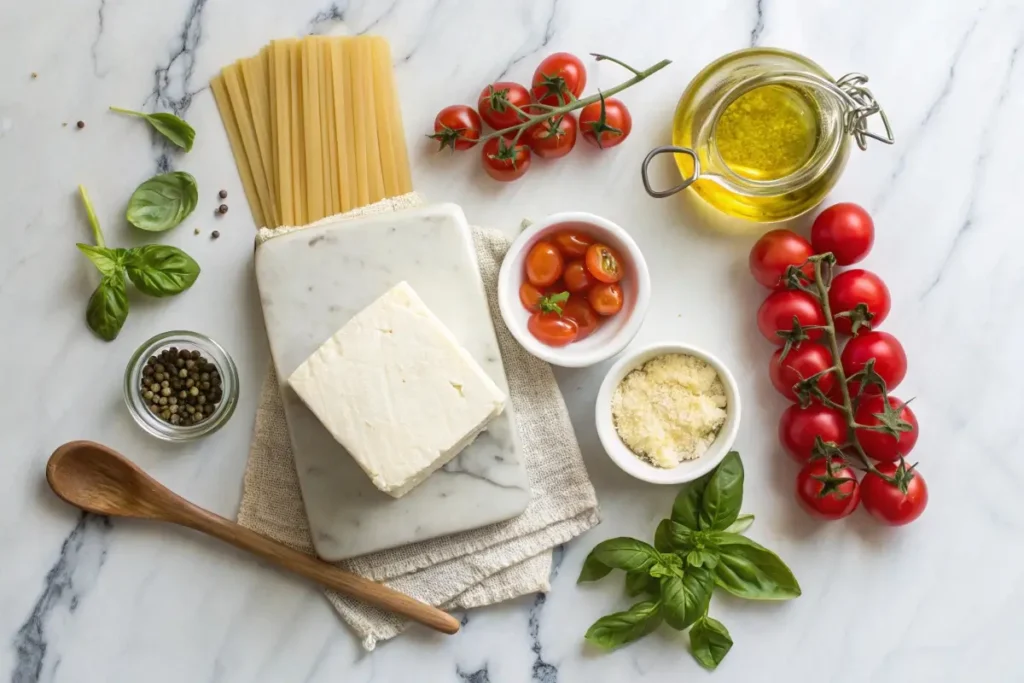
Feta Cheese: The Heart of the Dish
The star ingredient, feta cheese, is what gives baked feta pasta its creamy texture and tangy flavor. Baking a block of feta transforms it into a luscious, spreadable consistency that coats the pasta perfectly. For the best results, choose a high-quality block of feta made from sheep’s or goat’s milk. Avoid pre-crumbled feta, as it lacks the creaminess needed for this dish and may dry out during baking.
Cherry Tomatoes: Nature’s Sweetness
Cherry tomatoes are not just an addition—they are essential for creating the sauce. When roasted, they burst open, releasing their natural juices and caramelizing slightly for a rich, sweet flavor. Using a mix of colors—red, yellow, and orange—adds both visual appeal and subtle variations in taste.
Olive Oil: A Mediterranean Staple
A generous drizzle of extra virgin olive oil is key to bringing all the ingredients together. It ensures even roasting and adds a depth of flavor that enhances the dish’s richness. Choose a high-quality olive oil for the best taste, as its flavor shines through in the final product.
Pasta Varieties: Picking the Perfect Base
Short, ridged pasta shapes like penne, rigatoni, or fusilli work best for baked feta pasta. These shapes hold onto the creamy sauce, ensuring every bite is flavorful. For a healthier option, consider whole wheat or legume-based pasta. Gluten-free pasta also works well, making the dish suitable for various dietary needs.
Herbs and Seasonings: Elevating the Flavor
Fresh basil is the classic garnish for baked feta pasta, adding a pop of color and a fragrant finish. Don’t stop there—dried oregano, thyme, or rosemary can enhance the Mediterranean essence of the dish. For those who enjoy a bit of heat, red pepper flakes or freshly cracked black pepper add the perfect spicy kick.
Step-by-Step Recipe for Baked Feta Pasta
Preparation: Gathering and Prepping Ingredients
The first step to making the perfect baked feta pasta is gathering fresh, high-quality ingredients. You will need:
- 1 block of feta cheese (preferably made from sheep’s or goat’s milk)
- 2 cups of cherry tomatoes (red, yellow, or a mix)
- 10–12 oz of short pasta (penne, rigatoni, or fusilli)
- 1/4 cup of extra virgin olive oil
- Fresh basil leaves for garnish
- Salt, pepper, and optional red pepper flakes for seasoning
Before you start, preheat your oven to 400°F (200°C) and prepare a large ceramic or glass baking dish. Having everything ready ensures a smooth cooking process.
Baking the Feta and Tomatoes: Achieving the Perfect Roast
- Place the block of feta cheese in the center of your baking dish.
- Scatter the cherry tomatoes around the feta, ensuring an even layer.
- Drizzle olive oil generously over the cheese and tomatoes.
- Season with salt, pepper, and optional red pepper flakes.
- Roast in the preheated oven for 25–30 minutes, or until the tomatoes burst and the feta is golden and soft.
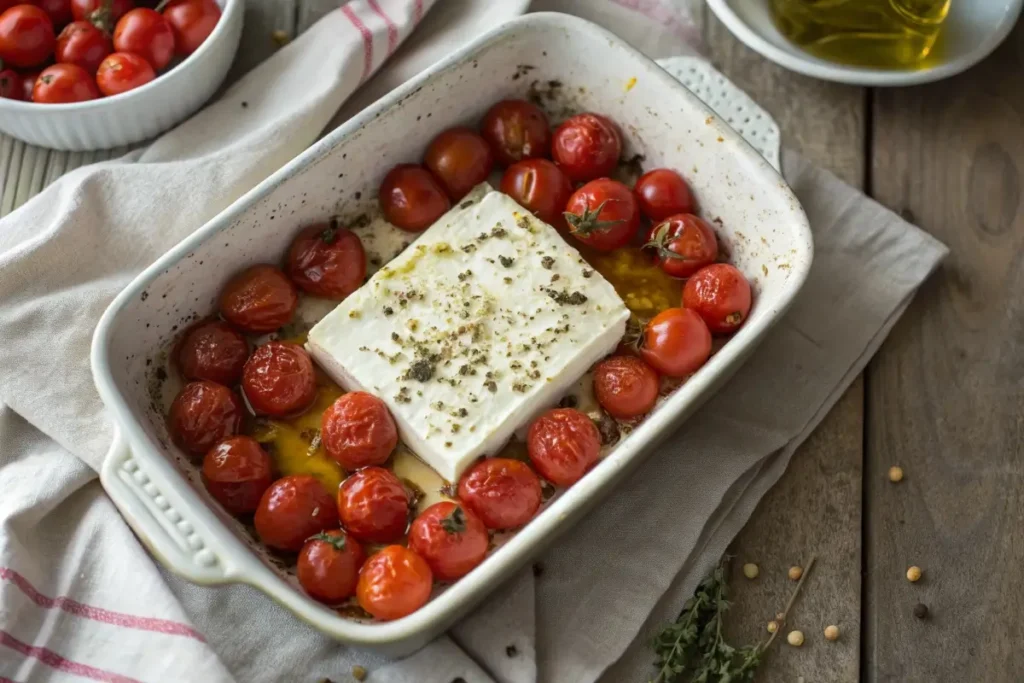
The key here is balance. The feta should be creamy, not dry, and the tomatoes should be caramelized but not overdone.
Cooking the Pasta: Tips for Al Dente Perfection
While your feta and tomatoes are roasting, cook the pasta in a large pot of salted boiling water. For optimal results:
- Use 4–5 quarts of water to ensure the pasta doesn’t stick together.
- Stir occasionally and cook the pasta until al dente, following package instructions.
- Reserve 1 cup of the starchy pasta water before draining. This will help create a silky sauce when combining the ingredients.
Combining Components: Creating a Creamy, Cohesive Dish
Once the feta and tomatoes are done baking:
- Use a fork to mash the feta and tomatoes into a creamy mixture, incorporating the juices released from the roasted tomatoes.
- Add the cooked pasta to the baking dish and toss everything together.
- Slowly pour in some reserved pasta water, stirring until the sauce reaches your desired consistency.
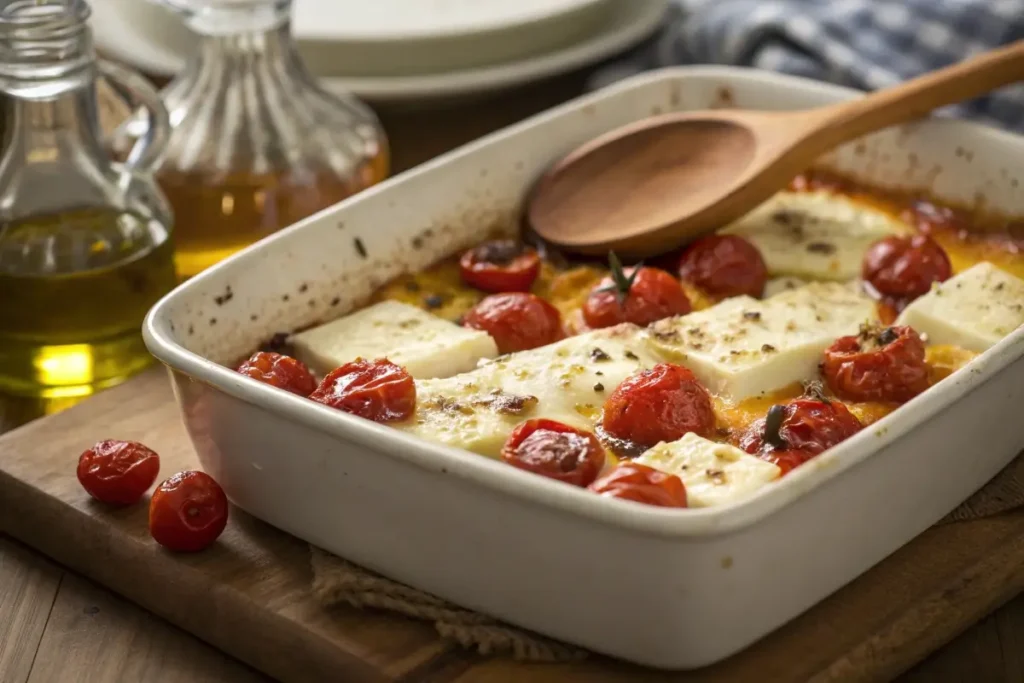
Serving Suggestions: Pairings and Presentation
Serve the baked feta pasta immediately, garnished with fresh basil leaves and an extra drizzle of olive oil for shine. Pair it with a crisp side salad or warm garlic bread to complete the meal. This dish is as visually stunning as it is delicious, making it perfect for dinner parties or a cozy night in.
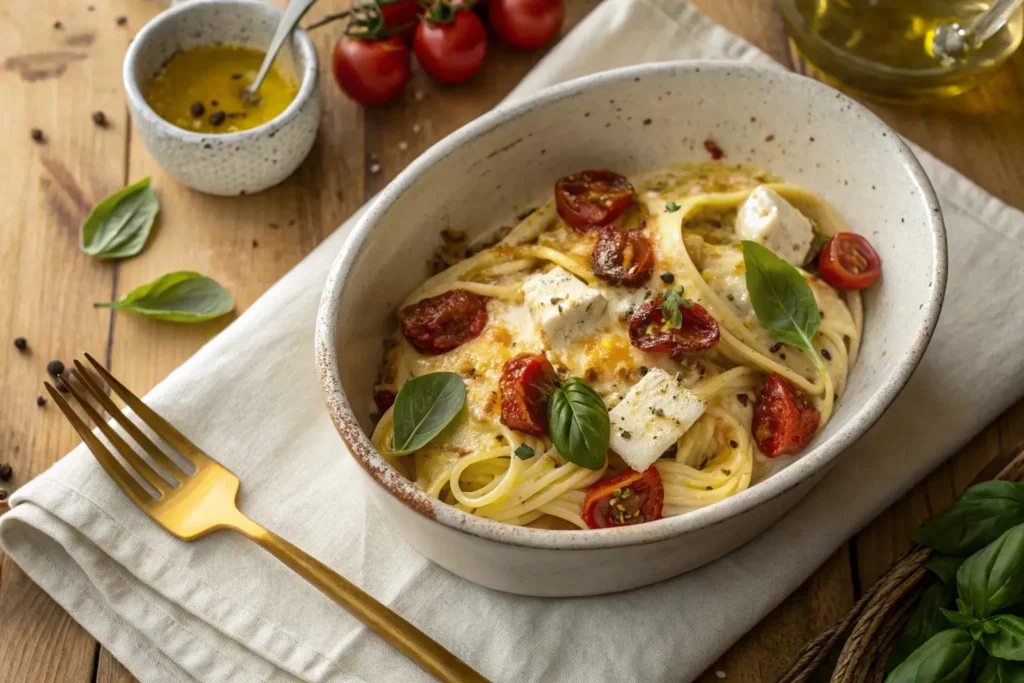
Variations and Enhancements
Incorporating Additional Vegetables: Spinach, Asparagus, and More
To make the dish more colorful and nutritious, consider adding vegetables. Stir fresh spinach or kale into the hot pasta right after mixing for a nutrient boost. Alternatively, roast bell peppers, asparagus, or zucchini alongside the tomatoes for extra texture and flavor.
Adding Proteins: Chicken, Shrimp, or Plant-Based Options
Transform your baked feta pasta into a protein-packed meal by including grilled chicken, sautéed shrimp, or crispy pancetta. For a vegetarian option, roasted chickpeas or crumbled tofu can add both protein and a delightful crunch.
Exploring Different Cheeses: Alternatives to Feta
Feta is iconic, but other cheeses can bring their own unique touch. Try goat cheese for a tangy twist or ricotta for a milder, creamier result. For a richer flavor, consider using a mix of feta and Parmesan.
Spice It Up: Introducing Heat with Chili Flakes or Peppers
If you love bold flavors, don’t hold back on the spice. Add sliced jalapeños or sprinkle extra red pepper flakes over the dish before baking. A dash of smoked paprika can also add a subtle smokiness to the dish.
Nutritional Insights
Caloric Breakdown: Understanding the Dish’s Energy Content
A single serving of baked feta pasta (approx. 1.5 cups) contains:
- Calories: 457
- Carbs: 77 grams
- Protein: 12 grams
- Fats: 12 grams
This makes it a filling and balanced option for lunch or dinner.
Macronutrient Composition: Balancing Carbs, Proteins, and Fats
The carbohydrates in the pasta provide quick energy, while the protein in feta cheese supports muscle repair and satiety. The fats from olive oil and feta enhance flavor and keep you feeling full.
Health Benefits of Key Ingredients: Tomatoes, Olive Oil, and Feta
- Tomatoes: High in antioxidants like lycopene, which may reduce the risk of heart disease.
- Olive Oil: Contains healthy monounsaturated fats that support cholesterol levels and heart health.
- Feta Cheese: A rich source of calcium and protein, promoting bone health.
Tips for Making a Lighter Version
To enjoy baked feta pasta without the guilt:
- Use whole wheat or legume-based pasta to increase fiber and protein content.
- Opt for reduced-fat feta to lower the calorie count.
- Load up on vegetables like zucchini noodles (zoodles) to reduce carbs while adding volume.
Tools and Equipment for Perfect Baked Feta Pasta
Baking Dish: The Right Size and Material
Choosing the right baking dish is crucial for evenly cooking your baked feta pasta. A ceramic or glass dish works best, as they distribute heat evenly and prevent sticking. The size of the dish should comfortably fit the block of feta and tomatoes without overcrowding. A standard 9×13-inch dish is ideal for most recipes.
Mixing Tools: Forks, Spoons, and Tongs
A sturdy fork is your best friend for mashing the roasted feta and tomatoes into a creamy sauce. For mixing the pasta, silicone tongs or a wooden spoon are recommended to ensure even coating without damaging the pasta.
Oven and Timer: Precision Matters
Set your oven to 400°F (200°C) for the perfect balance between roasting the tomatoes and softening the feta. Use a reliable timer to avoid overcooking\u2014the feta should be golden and creamy, while the tomatoes should just start to burst. Consistency in timing ensures the best results every time.
Optional Additions for Convenience
- Pasta Strainer: For draining your pasta efficiently without losing any of that precious starchy water.
- Zester or Grater: If you want to add a citrusy finish with lemon zest or sprinkle Parmesan cheese on top.
Common Mistakes to Avoid
Overbaking the Feta: Preventing Dryness
One common mistake is leaving the feta in the oven for too long. Overbaked feta can become crumbly and lose its creamy texture. Remove it from the oven as soon as the edges turn golden brown and the cheese softens.
Underseasoning: Ensuring a Flavorful Outcome
Forgetting to season your ingredients is another pitfall. Salt and pepper bring out the natural flavors of the feta and tomatoes, while additional spices like garlic powder or red pepper flakes elevate the dish. Always taste and adjust your seasoning before serving.
Choosing the Wrong Pasta: Impact on Texture
Avoid using long, smooth noodles like spaghetti or linguine. These don’t hold the sauce as effectively as short, ridged pasta like fusilli or rigatoni. The sauce clings better to textured shapes, ensuring every bite is full of flavor.
Ignoring Pasta Water: Achieving a Silky Sauce
Don’t skip reserving pasta water! This starchy liquid is key to loosening the sauce and achieving the desired creamy consistency. Add it gradually while mixing to prevent the dish from becoming too watery or dry.
Skipping Fresh Ingredients
Using canned tomatoes or pre-packaged garlic may save time but compromises flavor. Fresh cherry tomatoes and high-quality feta are essential for capturing the authentic Mediterranean essence of the dish.
Frequently Asked Questions
How Did Baked Feta Pasta Gain Recognition?
Baked feta pasta gained recognition after Finnish food blogger Jenni Häyrinen shared her recipe, “Uunifetapasta,” in 2019. However, its global popularity skyrocketed in 2020 when TikTok users embraced the dish, sharing millions of videos showcasing its simplicity and deliciousness. The vibrant colors, creamy texture, and ease of preparation made it a viral hit, appealing to home cooks worldwide.
What Type of Feta Is Best for Baking?
The best feta for baking is a block of feta made from sheep’s milk or a combination of sheep’s and goat’s milk. These types are creamier, tangier, and more flavorful compared to cow’s milk feta, which tends to be drier and less rich. Always choose a high-quality block of feta to achieve the creamy, luxurious texture that defines baked feta pasta.
Is Feta Good in Pasta?
Absolutely! Feta cheese adds a tangy, creamy flavor that pairs beautifully with pasta. Its salty and slightly acidic taste balances the richness of other ingredients, such as olive oil and roasted tomatoes. Whether crumbled over cold pasta salads or baked into a creamy sauce, feta elevates the dish with its bold Mediterranean flair.
Why Is My Feta Pasta Not Creamy?
If your feta pasta isn’t creamy, it’s likely because of overbaking the feta or using pre-crumbled feta. Overbaking can dry out the cheese, while pre-crumbled feta lacks the moisture needed for a creamy texture. To fix this, always use a block of feta and mash it immediately after baking. Adding reserved pasta water while mixing also helps create a silky sauce.
Does Feta Melt Creamy?
Feta doesn’t melt completely like mozzarella or cheddar. Instead, it softens into a spreadable, creamy consistency when baked. This unique texture is what makes it perfect for creating a rich sauce in dishes like baked feta pasta.
How Do You Make Pasta More Moist?
To make pasta more moist, use reserved pasta water while mixing. The starch in the water helps bind the sauce to the pasta, creating a creamy, cohesive texture. Adding a drizzle of olive oil or stirring in a bit of cream can also enhance moisture. If the pasta seems too dry, add small amounts of liquid (pasta water, broth, or even milk) until it reaches your desired consistency.
Perfect Pairings: What to Serve with Baked Feta Pasta
Fresh Salads
Pair your baked feta pasta with a light Mediterranean salad featuring cucumbers, cherry tomatoes, red onions, and Kalamata olives. A drizzle of lemon vinaigrette adds brightness and complements the rich, creamy pasta.
Garlic Bread or Crusty Bread
Nothing beats dipping warm, crusty bread or garlic bread into the creamy sauce. The combination of textures makes this a perfect side for your pasta.
Light Soups
A bowl of tomato soup or a simple vegetable broth can be a great starter, balancing the richness of the main dish. These options add warmth and additional flavors to your meal.
Roasted Vegetables
Roasted vegetables like zucchini, eggplant, or asparagus can be served alongside the pasta. Their smoky flavors pair beautifully with the tanginess of the feta.
Conclusion
Baked feta pasta is a true testament to the magic of simplicity. With just a handful of fresh ingredients, you can create a dish that’s creamy, flavorful, and versatile enough to suit any occasion. From its viral beginnings to its enduring popularity, this recipe has proven to be a timeless favorite for pasta lovers everywhere.
Whether you follow the classic recipe or experiment with your own variations, baked feta pasta offers endless possibilities for customization. Add your favorite vegetables, proteins, or spices to make it your own. It’s a dish that brings comfort and joy with every bite.
So, why not try it today? With its creamy sauce, vibrant Mediterranean flavors, and easy preparation, baked feta pasta is guaranteed to impress your taste buds and leave you coming back for more. It’s the perfect meal for busy weeknights, family dinners, or even a cozy night in. Bon appétit!
